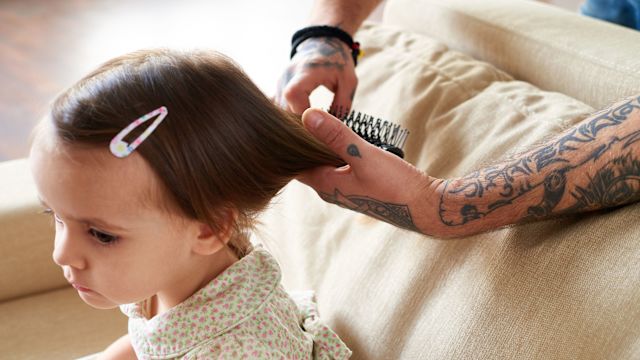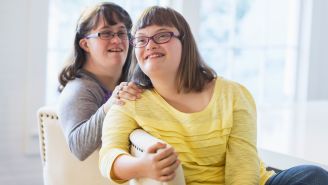Grade school rites of passage often include that dreaded note you may have received before: head lice in your child's class. Thankfully, shaved heads and toxic sprays are not your only recourses.
Sarah Turner, DO, is director of osteopathic medicine for LewisGale Hospital Montgomery, Family Medicine in Blacksburg, Virginia and a former team physician for the Virginia Tech Hokies and Blacksburg High School Bruins. Over the years treating young children and athletes of every age, she’s earned valuable insights into dealing with these pesky critters.
The most important thing, Dr. Turner explains, is to separate the facts about head lice from the fiction so that children, parents, and educators can most effectively avoid them.
Fact: head lice is common
Despite the first reaction many parents have (“Why me?!”) when spotting a louse on their child’s head, it’s important to remember that lice is very common among school kids.
According to the Centers for Disease Control and Prevention (CDC), an estimated 6 to 12 million cases occur each year in the United States among kids 3 to 11 years of age.
They tend to spike around back-to-school time in the fall and again in January, according to the U.S. Food and Drug Administration (FDA), though outbreaks can crop up year-round.
Factors that enhance the spread of lice
Preventing lice begins with an understanding of how they thrive and spread.
“In order for lice to live and create eggs, they need heat—body heat in particular—and they need to feed on blood,” Turner says. “The other risk factor for infestation is the combination of crowded conditions and close contact.”
Lice spread most commonly through head-to-head contact, so it makes sense that younger kids—particularly those attending preschool, childcare, or elementary school—are more likely than older kids to pick them up. The reason has to do with social habits rather than biology: Small children are more likely than older kids (or adults) to play in groups in closer proximity to one another and to share items like hats, scarves, and hair products.
Girls also appear to be more prone to head lice than boys, though the reasons are not fully established. Hair length may be a factor—more hair means more potential surface area to contact with other hair—and some schools in the throes of infestation advise that girls wear their hair up. But research into hair length isn’t conclusive.
“Whether it’s pigtails or ponytails, it’s not going to make that tremendous of a difference,” says Turner. The more likely factor is the way girls interact socially.
“Girls are at higher risk of lice infestation because of female social norms,” Turner notes. “They’re more inclined to have closer contact with one another—hugging, snuggling, and head-to-head chats.”
Prevention starts at home
While setting up a regular regime of preventive combing “is probably a waste of time,” says Turner, it does make sense to regularly run your hands through your child’s hair to be on the lookout for live lice or eggs (nits).
“You want to get close to the scalp,” she says. “The eggs are probably a little easier to see if the hair is dry because the hair can be separated more.”
Shorter hair is easier to scan, but Turner advises against taking cuts to the extreme.
“The only hairstyle that has been proven to be effective against infestations and recurrences is a shaved head,” Turner notes. “But I would never recommend shaving a young girl's head if she didn't want that.”
What to do if lice are on the prowl
If you do have reason to believe that a friend or classmate of your child may have lice, you’ll want to start by deploying the following avoidance measures:
Avoid head-to-head contact
Since direct contact is the main means of conveyance, both the CDC and the FDA advise instructing children to avoid head-to-head contact with friends and classmates (at home and at school).
Stop sharing headgear
The research is mixed on whether lice can be transferred via headwear or hair products, but both agencies recommend that children avoid sharing clothes, hats, scarves, headphones, and towels, as well as hair products such as combs, brushes, bandanas, and hair ties. (One exception is protective headgear including bicycle and sports helmets: The benefit of safeguarding against injury outweighs the potential nuisance posed by lice.)
Don’t pile on
It’s also smart to avoid keeping items in piles, whether at home, day care, or school. “When headwear or clothing from different children is left in a pile, a louse or a nit could get transferred to a new child when the item is put on,” says Turner. A better move is to have students assigned individual hooks, lockers, or cubbies for storing clothing and other items—and trying the same method for visitors to your home.
Some strategies aren’t worth your time (or money)
You may have heard about—or even tried—sprays and shampoos made with botanical ingredients such as tea tree oil or rosemary that claim to repel lice.
“There is no evidence to support that,” says Turner. “Buying a shampoo that has tea tree blend is probably not going to hurt your child, but it’s not going to do much in comparison to identifying the source of the infestation and making sure that the source—and anyone else who has suffered the consequences of the infestation—are appropriately treated.”
If you suspect an infestation at home
If your child displays any of the telltale signs of head lice (including itching, sores caused by scratching, a tickling or moving feeling in the hair, or irritability in bed or difficulty sleeping), you’ll want to determine for sure whether your child has lice.
The best method for making a diagnosis is to comb his or her hair with a fine-tooth comb as close to the scalp as possible, section by section, looking for live lice and nits. Wet combing using a lubricant such as conditioner may help ease the comb through the hair.
If you detect live lice, you’ll need to treat the problem, typically by using a combination of medicated shampoo, ointment, or lotion and wet combing, though you may be able to treat lice through combing alone. Check with your pediatrician about the treatment methods that would best suit your child’s age and your comfort level with chemical preparations.
While treating an infestation in your home, you can also take some steps to help prevent the problem from spreading. These measures are optional and would not replace treating the problem directly with medicine and/or thorough combing.
Keep combs and brushes clean
Avoid sharing combs and brushes used by anyone with lice and soak them in water heated to at least 130°F for 5 to 10 minutes to disinfect.
Keep your head up
Avoid lying on beds, pillows, sofas, rugs, or stuffed animals that have recently been in contact with a person with lice, and vacuum areas of your home, including furniture, where the infested person has sat or lain.
Make a laundry run
Wash and dry clothes, sheets and other items that have been in contact with the head of a person with lice during the prior two days using hot water (at least 130°F) and a dryer on high heat. If an item is not washable, have it dry-cleaned or stash it in an air-tight plastic bag for at least two weeks. (Live lice can’t survive longer than two days without a blood meal, and nits can’t survive without the warmth of a host for longer than about a week.)
One measure you can definitely skip: The CDC and FDA advise against using fumigant sprays or fogs because they are unlikely to help prevent lice and may be hazardous if inhaled or absorbed through the skin.
Education is key
It’s important to recognize that lice infestations occur regardless of personal hygiene or the cleanliness of one’s home.
“Often, an outbreak at school will be pegged on the poor kid or the ‘dirty kid,’ but that has nothing to do with it,” Turner says. She says it’s important to do away with head lice stigma and myth and to instead educate everyone involved with at-risk populations.
Along with social stigma, another old-school practice that many experts hope to see fall by the wayside is the “no-nit policy” enforced by some schools. These prohibit children from being in school as long as lice eggs are observed in the child’s hair.
“Not only have these policies shown not to work,” says Turner, “but they instill fear, contribute to more stigma, and unnecessarily keep kids out of school.”
The American Academy of Pediatrics and the National Association of School Nurses recommend against no-nit policies. They argue that children should attend school while receiving treatment at home for lice, allowing for the reality that nits may persist in a child’s hair for part of the course of treatment without jeopardizing other children with infestation.
The CDC notes that no-nit policies are often ineffective because not all nits hatch into lice and they are unlikely to transfer to other people (since they remain stuck to hair shafts). Nits are also not always accurately diagnosed by school staff and may be confused with dandruff.
“From the medical perspective,” Turner says, “we see that educational programs absolutely help.”
In other words, the more informed parents, students, and teachers are about lice, the more likely it is that preventive strategies will work—and that social stigmas and misunderstandings will subside.







